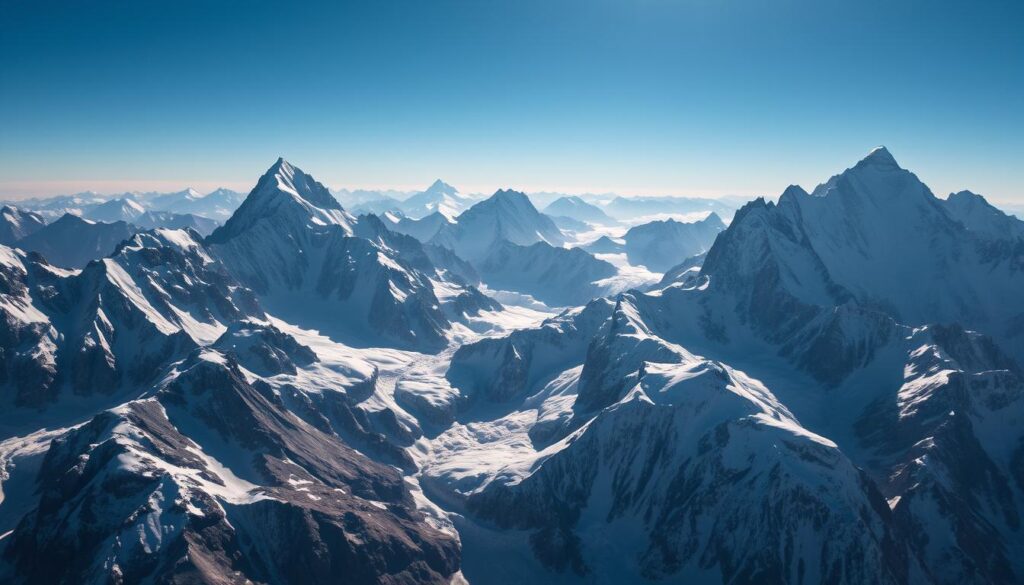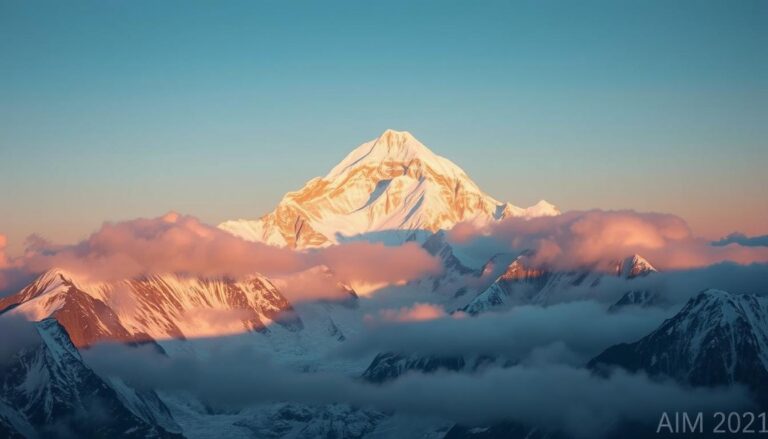Mount Everest, the highest peak, is a breathtaking natural wonder. It has captivated people worldwide. Located in the Himalayan mountain range, it stands at an impressive 29,029 feet above sea level. This makes it a formidable challenge for climbers and adventurers. The extreme altitude and harsh weather conditions make it one of the most difficult climbs. Yet, its majestic beauty and allure continue to draw people to it. As the highest peak, sleeping beauty mount everest is a source of fascination. Its unique and captivating landscape is not only challenging but also breathtakingly beautiful.
The combination of Mount Everest’s extreme altitude, harsh weather, and majestic beauty make it unique. It earns the nickname of the sleeping beauty of the highest peak. Whether you’re a seasoned climber or just appreciate nature, Mount Everest leaves a lasting impression.
Its stunning landscapes and challenging climbing routes make it a true wonder of the natural world.
The Majestic Crown of Earth: An Introduction to sleeping beauty mount everest
Mount Everest is the highest point on Earth, captivating people worldwide. It’s in the Himalayas, on the Nepal-Tibet, China border. Its extreme altitude and varied geology make it a thrilling place for adventurers and nature lovers.
The Indian tectonic plate’s movement towards the Eurasian plate formed Everest. This process, started millions of years ago, continues today. It has pushed the Himalayas up, creating Everest and other high peaks.

Geographic Location and Basic Statistics
Everest is in the Mahalangur Himal sub-range, known for its high altitude and varied geology. Its location in a seismically active area means frequent earthquakes. The area’s steep valleys, glaciers, and snow-capped peaks make climbing Everest a unique challenge.
The Formation of Earth’s Highest Point – sleeping beauty mount everest
The creation of Everest is a complex process. The Indian tectonic plate is moving towards the Eurasian plate at 2 inches per year. This movement raises the Himalayas by 1 inch annually, forming the world’s highest peaks.
Why sleeping beauty mount everest Commands Global Attention
Everest’s extreme altitude, challenging routes, and stunning views draw global attention. It’s a favorite among adventurers and nature enthusiasts. Scientists and explorers also visit to study its geology, ecology, and climate.
The Natural Splendor of the Sleeping Beauty Mount Everest
Mount Everest scenery is truly stunning, with its snow-capped peak and rugged terrain. It’s a paradise for trekkers and nature enthusiasts. The mountain’s high altitude and unique geography support a wide range of plants and animals, including endangered species.
The area around Mount Everest boasts majestic valleys, towering peaks, and charming villages. The natural beauty of the mountain inspires and reminds us of the need to protect our planet. Key features of the scenery include:
- Majestic valleys and towering peaks
- Picturesque villages and traditional settlements
- Unique and diverse flora and fauna
- Breathtaking landscapes and scenery
Preserving Mount Everest’s natural beauty is crucial. Conservation efforts and sustainable tourism are underway. By seeing the scenery, visitors can understand the value of protecting our planet.
Mount Everest’s natural splendor is a unique experience that draws visitors worldwide. The scenery and natural beauty show the incredible diversity of our planet.
Weather Patterns and Climate Zones of sleeping beauty mount everest
Mount Everest’s weather is extreme and hard to predict. It poses a big challenge to those who climb or trek here. The mountain’s high altitude and unique shape lead to different climate zones, from subtropical to arctic. Knowing these mount everest climate zones is key for safe climbing.
The death zone is above 26,000 feet. It’s very dangerous because of low oxygen, extreme cold, and strong winds. Climbers usually try to reach the top in spring and autumn. This is when the everest weather is a bit more stable.
Let’s look at some key factors:
- Low oxygen levels
- Extreme cold
- High winds
These factors make the death zone famous for being dangerous. They show why careful planning and preparation are crucial for climbers. By knowing the mount everest climate and everest weather, climbers can face the mountain’s challenges better. This increases their chances of reaching the summit successfully.
Flora and Fauna of the Mountain Kingdom: sleeping beauty mount everest
The everest flora is surprisingly diverse, given the harsh climate and extreme altitude. The lower slopes of Mount Everest are covered with dense forests of rhododendron, birch, and juniper. These forests provide a home for a variety of everest fauna.
As you climb higher, the plants adapt to the extreme conditions. The Himalayan poppy and the edelweiss thrive in the high-altitude meadows.
The mountain kingdom is home to several endangered species, like the snow leopard and the red panda. These animals have thick fur and a slow metabolism to survive. The everest fauna also includes birds, such as the Himalayan monal and the bearded vulture, which live in the region.
Some key features of the everest flora and everest fauna include:
- Adaptation to extreme conditions, such as high altitude and low temperatures
- Diverse range of plant and animal species
- Endangered species, such as the snow leopard and the red panda
- Unique habitats, such as high-altitude meadows and dense forests
The mountain kingdom of Mount Everest is a unique and fascinating ecosystem. It has a diverse range of everest flora and everest fauna. Despite the harsh climate and extreme altitude, the mountain supports a wide range of species. It’s a fascinating place for scientists and adventurers.
| Species | Habitat | Adaptation |
|---|---|---|
| Snow Leopard | High-altitude meadows | Thick fur, slow metabolism |
| Red Panda | Dense forests | Specialized digestive system |
| Himalayan Poppy | High-altitude meadows | Deep roots, small leaves |
The Human History of Everest Exploration
Mount Everest, the highest peak, has a rich history of exploration. The first attempts to climb it started in the early 20th century. This marked the beginning of a long journey for mountaineers.
Everest exploration is driven by human curiosity and the desire to explore the unknown. It shows our willingness to push beyond limits.
One major milestone was achieved by Sir Edmund Hillary and Tenzing Norgay in 1953. They successfully reached the summit. This achievement opened the door for future climbers and made Everest a legendary peak.
Notable Achievements: sleeping beauty mount everest
- Junko Tabei became the first woman to reach the summit in 1975
- Reinhold Messner achieved the first solo ascent in 1980
- Apex expeditions have continued to push the boundaries of everest exploration, with climbers attempting new routes and achieving remarkable feats
Today, the history of climbing Everest keeps growing. New challenges and achievements are made every year. We thank the pioneers of Everest exploration for their inspiration and motivation.
Challenges and Dangers of Climbing Everest
Climbing Mount Everest is a big challenge. It faces climbers with extreme altitude, harsh weather, and steep terrain. The death zone, above 26,000 feet, is especially dangerous. It has low oxygen, extreme cold, and high winds.
Climbers also face dangers like crevasses, avalanches, and rockfall. These can be deadly. Climbing Mount Everest is expensive, both in money and effort. It requires careful planning and preparation.
- Extreme altitude and low oxygen levels
- Harsh weather conditions, including extreme cold and high winds
- Steep terrain and difficult climbing routes
- Crevasses, avalanches, and rockfall
- High cost, both financially and physically
Despite these challenges, many are drawn to Everest’s beauty and the feeling of reaching the top. Climbers must approach with caution and respect for the mountain.
Understanding the dangers and challenges helps climbers prepare. With the right planning and respect for the mountain, they can safely reach the summit.
Environmental Conservation and Future Preservation
Mount Everest, the highest peak, faces big environmental challenges. Everest conservation efforts are key to keep its natural beauty and ecosystem safe. The mount everest environmental impact is growing, with glaciers melting fast due to rising temperatures.
More climbers and trekkers mean more waste. To tackle this, waste management programs are being set up. These aim to lessen the environmental harm from human activities. Also, promoting sustainable tourism helps the local economy and protects the environment.
Some important steps for everest conservation include:
- Implementing waste management programs to reduce pollution
- Promoting sustainable tourism practices to support the local economy
- Supporting climate change mitigation efforts to reduce the mount everest environmental impact
Together, we can save Mount Everest’s beauty and ecosystem for the future. The everest conservation efforts need everyone’s help. It’s vital to spread the word about the mount everest environmental impact to ensure the mountain stays sustainable.
| Initiative | Goal | Impact |
|---|---|---|
| Waste Management Programs | Reduce pollution | Preserve the environment |
| Sustainable Tourism Practices | Support the local economy | Promote eco-friendly tourism |
| Climate Change Mitigation Efforts | Reduce the mount everest environmental impact | Preserve the natural beauty of the mountain |
Conclusion: Preserving Earth’s Sleeping Giant for Future Generations
As we end our journey through Mount Everest, we must think about saving this natural wonder for the future. Mount Everest shows us the incredible power and beauty of our Earth. It’s a giant that we must respect and protect.
We face big environmental issues on the mountain. It’s up to us to use eco-friendly tourism, manage waste well, and fight climate change. Together, we can keep the Himalayas’ “Sleeping Beauty” a place of wonder for everyone.
Our work together can keep Mount Everest’s beauty alive for future explorers. Let’s promise to care for this amazing place. We must make sure the “Roof of the World” keeps inspiring and challenging adventurers for years to come.
FAQ’s
What is the geographic location of Mount Everest?
Mount Everest is in the Himalayan range. It’s on the border of Nepal and Tibet, China. It’s part of the Mahalangur Himal, known for its high altitude and unique geology.
How was Mount Everest formed?
Mount Everest formed when the Indian plate moved towards the Eurasian plate. This started millions of years ago and still happens today.
What are the main reasons why sleeping beauty mount everest commands global attention?
Mount Everest is famous for its high altitude, tough climbs, and stunning views. It attracts adventurers and nature lovers from around the world.
What are the weather patterns and climate zones of sleeping beauty mount everest?
Mount Everest’s weather is extreme and unpredictable. Its high altitude and unique shape create different climate zones. The death zone above 26,000 feet is especially dangerous due to low oxygen, cold, and strong winds.
What is the flora and fauna of the “Mountain Kingdom” of Mount Everest?
Mount Everest has a variety of plants and animals despite its harsh climate. The lower slopes have forests of rhododendron, birch, and juniper. Higher up, you find endangered species like the snow leopard and red panda.
What is the history of human exploration of sleeping beauty mount everest?
Exploring Everest is a story of adventure and achievement. The first attempts to climb Everest were in the early 20th century. Sir Edmund Hillary and Tenzing Norgay’s 1953 summit was a major milestone.
What are the main challenges and dangers of climbing Mount Everest?
Climbing Everest is tough due to its high altitude, harsh weather, steep terrain, and other dangers. The death zone above 26,000 feet is especially risky. Climbing Everest is expensive and physically demanding, requiring careful planning.


